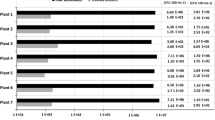Abstract
During the passage of sewage through a typical treatment plant employing biological filter beds and operating under dry weather flow conditions, about 7% of the input of anaerobic organisms survive to be released in the effluent. The greatest fall in numbers occurs in the first of two primary settling tanks operating in series and during passage through the filter beds. The predominant organisms were Bacteroides species, gram-positive cocci and clostridial species. There is no significant difference in the rate of survival of any of the genera through the different stages of treatment.
Similar content being viewed by others
References
Bryant, M. P. and Burkey, L. A. 1953. Cultural methods and some characteristics of some of the more numerous groups of bacteria in the bovine rumen. — J. Dairy Sci. 36: 205–217.
Curds, C. R. and Hawkes, H. A. (eds). 1975. Ecological Aspects of Used-Water Treatment, Vol. 1: The Organisms and their Ecology. — Academic Press, London.
Daily, O. P., Joseph, S. W., Gillmore, J. D., Colwell, R. R. and Seidler, R. J. 1981. Identification, distribution, and toxigenicity of obligate anaerobes in polluted waters. — Appl. Environ. Microbiol. 41: 1074–1077.
Essers, L. 1982. Simple identification of anaerobic bacteria to genus level using typical antibiotic susceptibility patterns. — J. Appl. Bacteriol. 52: 319–323.
Higgins, I. J. and Burns, R. G. 1975. The Chemistry and Microbiology of Pollution. — Academic Press, London.
Hobson, P. N. and Shaw, B. G. 1974. The bacterial population of piggery-waste anaerobic digesters. — Water Res. 8: 507–516.
Holdeman, L. V., Cato, E. P. and Moore, W. E. 1977. Anaerobe Laboratory Manual, Fourth edition. — Virginia Polytechnic Institute, Blacksburg, Virginia.
Post, F. J., Allen, A. D. and Reid, T. C. 1967. Simple medium for the selective isolation of Bacteroides and related organisms, and their occurrence in sewage. — Appl. Microbiol. 15: 213–218.
Toerien, D. F. 1970. Population description of the non-methanogenic phase of anaerobic digestion — I. Isolation, characterization and identification of numerically important bacteria. — Water Res. 4: 129–148.
UUeki, A., Miyagawa, E., Minato, H., Azuma, R. and Suto, T. 1978. Enumeration and isolation of anaerobic bacteria in sewage digestor fluids. — J. Gen. Appl. Microbiol. 24: 317–332.
Van Houte, J. and Gibbons, R. J. 1966. Studies of the cultivable flora of normal human feces. — Antonie van Leeuwenhoek 32: 212–222.
Willis, A. T. 1977. Anaerobic Bacteriology: Clinical and Laboratory Practice, Third edition. —Butterworths, London.
Author information
Authors and Affiliations
Rights and permissions
About this article
Cite this article
Thirkell, D., Thakker, B., Clark, L.S. et al. The survival of anaerobes during sewage treatment employing biological filter beds. Antonie van Leeuwenhoek 51, 71–78 (1985). https://doi.org/10.1007/BF00444230
Issue Date:
DOI: https://doi.org/10.1007/BF00444230



